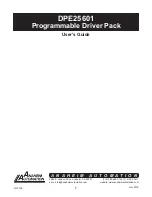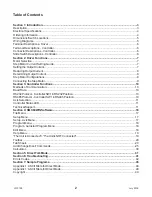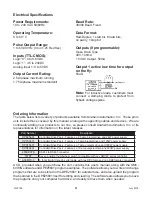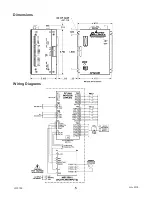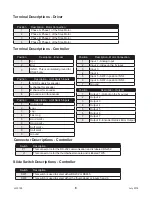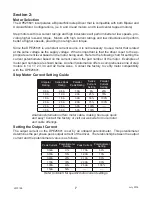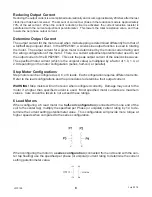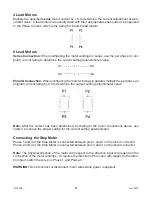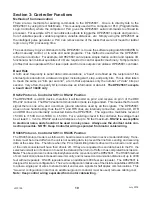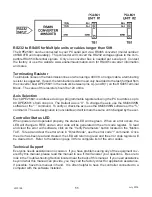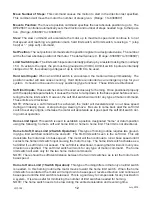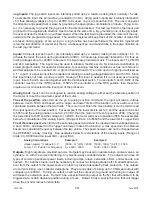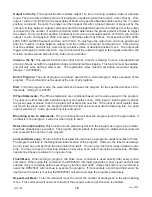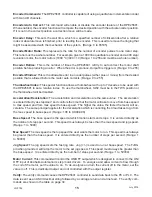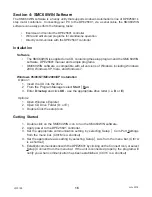
August 2012
L010199
10
Methods of Communication
There are two methods for sending commands to the DPE25601. One is to directly talk to the
DPE25601 by using Direct Talk Mode. This is usually used with a computer or PLC (Programmable
Logic Controller), where the computer or PLC gives the DPE25601 serial commands to off-load its
processor. For example: A PLC can utilize its outputs to toggle the DPE25601’s inputs and gain con-
trol of variable speeds, variable programs, variable distances, etc. Simply using the DPE25601 as
the intelligent pulse generator, a PLC can remove some of the tasks that were not meant for ladder
logic or any PLC processing time.
The second way to give commands to the DPE25601 is to use the software program SMC60WIN to
either manually control, or to write and send programs. This method is used when the DPE25601
is the main controller. For example: A DPE25601 can replace simple motion control and replace I/O
functional when minimal quantities of I/O are required to control specific machinery. Simple motion
profiles that can operate with 6 or less inputs and 8 or less outputs can utilize a DPE25601 controller.
Baud Rate
A term used frequently is serial data communications, a “baud” is defined as the reciprocal of the
shortest pulse duration in a data word signal, including start, stop, and parity bits. This is often taken
to mean the same as “bits per second”, a term that expresses only the number of “data” bits per
second. Very often, the parity bit is included as an information or data bit.
The DPE25601 accepts
a baud rate of 38400 only
.
RS232 Protocol - Controller SW1 in RS232 Position
The DPE25601 is a DCE device, therefore it will transmit on pin 2 and receive on pin 3 of the DB9
RS-232 connector. The RS232 serial communication mode is single ended. This means that for each
signal there is one wire, and a common ground reference used by all the signals. The DPE25601
does not use handshaking, thus the CTS and RTS lines are internally connected, and the CD, DTR
and DSR lines are internally connected inside the DPE25601. The signal line maintains levels of
+5VDC to +15VDC and -5VDC to -15VDC. For a valid logic level in the controller, the voltage must
be at least +/- 3 volts. RS232 works at distances of up to 50 feet maximum.
RS232 is susceptible
to electrical noise, and should not be used in noisy areas. Always use the shortest cable con
-
nection possible. NOTE: Keep Controller wiring separated from motor cable/wiring.
RS485 Protocol - Controller SW1 in RS485 Position
The RS485 protocol mode is as follows; On board receivers will remain in active mode indefinitely. Trans
-
mitters must be turned off when the unit is not sending data, to prevent the line from sending and receiving
data at the same time. Therefore when the PC is transmitting data its driver will be turned on and each
of the units connected will have their drivers off. If they are requested to send data back to the PC, the
selected unit will turn it’s driver on to send the data and then turn it off after it has completed transmission.
Note:
The above protocol is done internally between the converter and the DPE25601. The RS485 method
of communication allows increased noise immunity and increased communication distance of up to 4000
feet without repeaters. RS485 repeaters allow an additional 4000 feet per repeater. The DPE25601 is
designed for two wire configuration. The 2 wire configuration makes use of the tristate capabilities of RS485
to allow a single pair of wires to share transmit and receive signals for half duplex communications. This
“two wire” configuration (note that an additional ground conductor must be used) reduces cabling cost.
Note: Keep control wiring separated from motor cable/wiring.
Section 3: Controller Functions
July 2018

